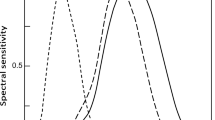Summary
Additive color mixture experiments were performed in the goldfish using a behavioral training technique in which the fish had to discriminate between two test fields.
-
1.
When trained on monochromatic light of 570, 584, 599 or 608 nm, and tested against an additive mixture of 523 nm and 641 nm, the fish showed a “match” at certain mixture ratios. This was also the case when trained on 484, 490 or 495 nm, and tested against an additive mixture of 471 nm and 523 nm.
-
2.
To match 404 nm, an additive mixture of 434 nm and 367 nm was necessary, whereas a mixture of 434 nm and 683 nm was always clearly discriminable.
-
3.
For equality with the “white” light of a xenon-arc lamp, an additive mixture of 4 primary wavelengths was necessary and sufficient: 641, 523, 434 and 367 nm. This mixture was also equal to a mixture of 404 nm and 599 nm, and to a mixture of tungsten-“white” and UV.
-
4.
The results can be qualitatively explained on the basis of the 4 cone types of the goldfish. For a quantitative description, cone sensitivity functions modified by inhibitory interactions have to be assumed. — Color vision in goldfish is tetrachromatic.
Similar content being viewed by others
References
Arnold K, Neumeyer C (1987) Wavelength discrimination in the turtle Pseudemys scripta elegans. Vision Res 27:1501–1511
Avery JA, Bowmaker JK, Djamgoz MBA, Downing JEG (1983) Ultraviolet sensitive receptors in a freshwater fish. J Physiol (Lond) 334:23P
Bowmaker JK (1990) Visual pigments of fishes. In: Douglas RH, Djamgoz MBA (eds) The visual system of fish. Chapman and Hall, London New York Tokyo Melbourne Madras, pp 81–107
Bowmaker JK, Thorpe A, Douglas RH (1991) Ultraviolet-sensitive cones in the goldfish. Vision Res 31:349–352
Frisch K von (1913) Weitere Untersuchungen über den Farbensinn der Fische. Zool Jahrb, Abt Zool Physiol 34:43–68
Hamburger V (1926) Versuche über Komplementärfarben bei Ellritzen (Phoxinus laevis). Z Vergl Physiol 4:286–304
Hárosi FI (1976) Spectral relations of cone pigments in goldfish. J Gen Physiol 68:65–80
Hárosi FI (1985) Ultraviolet- and violet-absorbing vertebrate visual pigments: dichroic and bleaching properties. In: Fein A, Levine JS (eds) The visual system. Alan R Liss, New York, pp 41–55
Hárosi FI, Hashimoto Y (1983) Ultraviolet visual pigment in a vertebrate: a tetrachromatic cone system in the dace. Science 222:1021–1023
Hawryshyn CW, Beauchamp R (1985) Ultraviolet photosensitivity in goldfish: an independent u.v. tretinal mechanism. Vision Res 25:11–20
Jacobs GH (1981) Comparative color vision. Academic Press, New York London Toronto Sydney San Francisco
Marks WB (1965) Visual pigments of single goldfish cones. J Physiol (Lond) 178:14–32
Menzel R (1981) Achromatic vision in the honeybee at low light intensities. J Comp Physiol 141:389–393
Neumeyer C (1984) On spectral sensitivity in the goldfish. Evidence for neural interactions between different “cone mechanisms”. Vision Res 24:1223–1231
Neumeyer C (1985) An ultraviolet receptor as a fourth receptor type in goldfish color vision. Naturwissenschaften 72:162–163
Neumeyer C (1986) Wavelength discrimination in the goldfish. J Comp Physiol A 158:203–213
Neumeyer C (1991) Evolution of color vision. In: Cronly-Dillon JR, Gregory RL (eds) Vision and visual dysfunction. Vol 2. Macmillan, Houndsmills London, pp 282–305
Neumeyer C (1992) On perceived colors. Behav Brain Sci 15:49
Oyama T, Jitsumori M (1973) A behavioral study of color mixture in the carp. Vision Res 13:2299–2308
Shefner JM, Levine MW (1976) A psychophysical demonstration of goldfish trichromacy. Vision Res 16:671–673
Thompson E, Palacios A, Varela FJ (1992) Ways of coloring. Comparative color vision as a case study for cognitive science. Behav Brain Sci 15:1–26
Tomita T, Murakami M, Pautler EL (1967) Spectral response curves of single cones in the carp. Vision Res 7:519–531
Van Dijk BW, Spekreijse H (1984) Color fundamentals deduced from carp ganglion cell responses. Vision Res 24:211–220
Whitmore AV, Bowmaker JK (1989) Seasonal variation in cone sensitivity and short-wave absorbing visual pigments in the rudd Scardinius erythrophthalmus. J Comp Physiol A 166:103–115
Wolff H (1925) Das Farbunterscheidungsvermögen der Ellritze. Z Vergl Physiol 3:279–329
Wyszecki G, Stiles WS (1982) Color science. (2nd edn.), Wiley, New York
Author information
Authors and Affiliations
Rights and permissions
About this article
Cite this article
Neumeyer, C. Tetrachromatic color vision in goldfish: evidence from color mixture experiments. J Comp Physiol A 171, 639–649 (1992). https://doi.org/10.1007/BF00194111
Accepted:
Issue Date:
DOI: https://doi.org/10.1007/BF00194111




